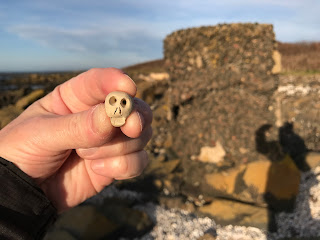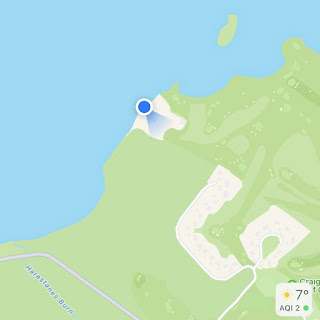I took a cycle out to Tranent in East Lothian
and stopped off along Dovecot Brae, by a crumbling, old building that is now
virtually hidden amongst trees and undergrowth.
If it weren’t for the stairs leading up from the road, it would be easy
to go right past this place and not even notice it was there. At first this building, Tranent Doocot,
appears to have no great importance or relevance, but there is a dark history associated
with the man who ordered its construction.
Stairs leading up to Tranent Doocot,
which is almost hidden in trees and undergrowth
Tranent Doocot – almost hidden in trees
and undergrowth
According to J Sands in his book published in
1881 'Sketches of Tranent in the Olden Times', Tranent Doocot used to bear the
name of David Setoun and the date 1587.
In the present day, this inscription is completely illegible, which is
not a bad thing given that David Setoun or Seton, as he is now known, was one
of the main instigators in starting what later became known as the North
Berwick Witch Trials.
Entrance to Tranent Doocot
Pigeonholes inside the doocot for the
birds to nest in.
David Seton was the Deputy Bailiff in Tranent
to Lord Seton and to make things nice and confusing David Seton also had a son
called David. In various descriptions of
him, David Seton Snr appears to be a mean spirited, suspicious man who believed
that his woes and financial difficulties were caused by others committing
ungodly acts against him. He, and his
family resided in Tranent in a house that was commonly known as the Royal
George, and in their employment was a maid servant called Geillis Duncan. Duncan is believed to have been in her early
to mid-teens when employed by Seton and is described as being '...young and
comely, and distinguished for her readiness to attend the sick and infirm, and
for her wonderful skill in curing diseases.'
In November 1590 David Seton became suspicious
of Duncan’s growing reputation as a healer and became convinced that witchcraft
must be involved. He then questioned her
about this, and she denied the accusations.
Not satisfied with this Seton gathered together some associates and
together they tortured Duncan. First,
they used an item called the 'pilliwinks' on her, or what we would today call
thumbscrews. These crushed the thumbs
and caused great pain. However, despite
this Duncan would not confess. Seton and
his associates then bound and wrenched her head with a rope to cause her
extreme agony, but still, she would confess nothing. They then stripped and
shaved her and examined her body for the mark of the Devil, as it was believed
that those in the service of Satan had a mark put upon them that was insensible
to pain and did not bleed when pricked.
On 'finding' this mark on Duncan's neck Seton and his cronies stated
that she then admitted that her looking after the sick had been done at the
suggestion of the Devil and that her curing of disease was done by
witchcraft. She went on to name thirty
accomplices. Duncan, and all those she
had named, were then imprisoned.
Terrified, tormented and tortured those
imprisoned soon confessed to a multitude of bizarre crimes including attempting
to bring about the death of King James VI.
The strange and wonderful story that emerged was that the coven of
witches met in the house of Barbara Napier in Edinburgh. Napier was a member of Edinburgh high society
and was Lady-in-Waiting to the Countess of Angus. She had fallen out with the Countess and had
then supposedly brought about the death of the Earl of Angus through the use of
witchcraft. As well as meeting at Napier’s
house, there had been a meeting of around two hundred witches at Acheson's
Haven (now Morrison's Haven, Prestongrange) and later another meeting at the
Kirk of North Berwick. The Devil
presided over these gatherings and Dr John Fian, a schoolteacher from
Prestonpans, acted as the secretary. The
coven had met to devise a plan to destroy the ship that carried the newly
married King James and his wife Anne from Denmark to Leith. At one of these meetings another member of
Edinburgh high society, Euphame MacCalzean, handed a waxen image of King James
to the Devil and hinted that the Earl of Bothwell, with whom she was closely
connected, would be the new king.
After the meeting at North Berwick a group of
witches and wizards set sail in sieves to meet the Royal ship. During their voyage they boarded a passing
ship and after helping themselves to food and drink, sunk it. They then carried on with their voyage and on
sighting the Royal ship the Devil handed a cat, that had earlier been baptised,
to Dr Fian and ordered him to throw it into the sea and cry 'Halo!' On his doing this a tremendous storm arose
and being convinced that nothing but a miracle could save the Royal ship from
destruction, the Devil and all those gathered returned to North Berwick. There they marched with their sieves in their
hands to the Kirk. Geillis Duncan led
the procession playing a quick step on the Jews Harp. At the Kirk they all entered, and the Devil
preached a sermon to them from the pulpit.
He asked all those assembled to do all the evil in their power and that
if they did so, they'd be handsomely rewarded.
He then bent over the pulpit and asked those assembled to kiss his
buttocks as a token of their allegiance.
They all did so before making their way out into the churchyard where
they feasted on the dead and were given parts of human bodies by the Devil as
powerful charms. Geillis Duncan then
played a reel on the Jews Harp called - 'Cummer, go ye before Cummer, go ye.'
All those seized and accused of witchcraft were
tortured horribly to make them confess to their roles in the plot. Dr Fian, the alleged secretary to the Devil
and cat thrower, had his legs crushed in the 'bootikens' until 'the blood and
marrow spouted out'. His fingernails were
then pulled out and pins pushed into his fingers, however unlike many of the others,
he refused to confess to anything.
King James took a keen interest in all the
proceedings of these witch trials, as he fully believed that an attempt had
been made on his life by Satan and his little helpers. Though why Satan would be interested in the
King of a small, poor country at the arse end of Europe is anyone's guess. You would have thought that given the chaos
that would later be caused by King James' son Charles, that the Devil would
have been only too keen to keep James and his offspring on the throne. Though maybe, unlike God, the Devil does not
reside outside of time and is therefore unaware of what is to come. Anyway, getting back to the story - King
James attended to see the witnesses examined and put to torture and also had
Geillis Duncan brought to Holyrood Palace in Edinburgh. There he had her play the reel on the Jews
Harp that she had played for the Devil and all the assembled witches and
wizards at North Berwick.
Various trials then took place and on 26
December 1590 John Fian was tried and found guilty of numerous charges
including being involved in the plot against King James. He was sentenced to death and it appears that
he may have been taken to Castle Hill and strangled and burned there later on
the same day.
Barbara Napier was tried and found guilty of
consulting with witches and was sentenced to death. On 10 May 1591 she was taken to Castle Hill,
Edinburgh where she was bound to a stake to be strangled and burned. However, she claimed to be pregnant and was
given a stay of execution. It is unclear
what then happened to her.
Euphame MacCalzean was found guilty of being a
witch and consulting with witches. She
was sentenced to death, though cruelly and unusually was sentenced to death by
being burned alive. The sentence was
carried out on Castle Hill on the 25 June 1591.
No trial records have ever been recovered for
Geillis Duncan. However, she was
convicted of witchcraft and was executed on 4 December 1591 at Castle Hill in
Edinburgh, presumably like the others by being strangled and then burned to
ashes. She was executed along with
Bessie Thomson, another woman convicted of witchcraft, and both recanted their
confessions prior to execution. On being
asked why she had confessed and named others such as Barbara Napier and Euphame
MacCalzean in her confessions Duncan stated that she had been made to by the
two David Setons in Tranent and others, but that it was all lies and for this
she begged God's forgiveness.
Many of those named by Duncan went on to name
others involved in the so called plot against the King, and by 1593 over 70
people had been implicated and many had been executed. Now, I may be being very cynical about the
reasons for many of these people being accused, as I am aware that there were
many religious, political, and socio-economic things going on at this
time. However, it is very interesting to
note that Dr John Fian had been in a long running dispute with David Seton,
while Euphame MacCalzean was Seton’s sister-in-law. Seton was angry with her, as she had
inherited money from a relative that he thought should have been bequeathed to
him. So, at the very least Seton would
appear to be guilty of capitalising on a situation, he had started, for revenge
against enemies, perceived and real.
* * *
Tranent Doocot stands near to Tranent Old
Parish Church and was built to house 1122 pairs of pigeons. The pigeons were a good supply of fresh meat
for the local population, who would take the young pigeons, as their meat was
the most tender and juicy. The building
has been partially restored but is again in a state of disrepair. I'm glad that the name of David Seton has
faded from this building, as it is a name that deserves to be forgotten. Instead let us remember the names of those
who died in an age of paranoia, religious intolerance, and political intrigue.

Tranent Old Parish Church with Doocot on
right hand side
I left a Skulferatu here for Geillis Duncan and
all the others who were persecuted and murdered for imaginary crimes created in
the overactive imaginations of jealous or malicious peers and a paranoid ruling
class.
Skulferatu #34
Skulferatu #34 in hollow of wall at
Tranent Doocot
Skulferatu #34 in hollow of wall at
Tranent Doocot
Map showing location of Skulferatu #34
The
coordinates for the location of the Skulferatu are –
Latitude 55.950036
Longitude
-2.957936
I used the following sources for the tale of
Geillis Duncan -
Witchcraft in Early Modern Scotland
edited by Lawrence Normand and Gareth Roberts
(2000)
Sketches of Tranent in the Olden Times
by J Sands (1881)
Available digitally at https://electricscotland.com/history/tranent/chapter03.htm
Tranent and its Surroundings
by P McNeill (1884)
https://archive.org/details/tranentitssurrou02mnei/mode/2up
Geillis Duncan, Witch
https://engole.info/geillis-duncan-witch/
Wikipedia - Morrison's Haven
Morrison's Haven - Wikipedia
Article and photographs are copyright of © Kevin Nosferatu, unless otherwise stated.
















































.jpg)